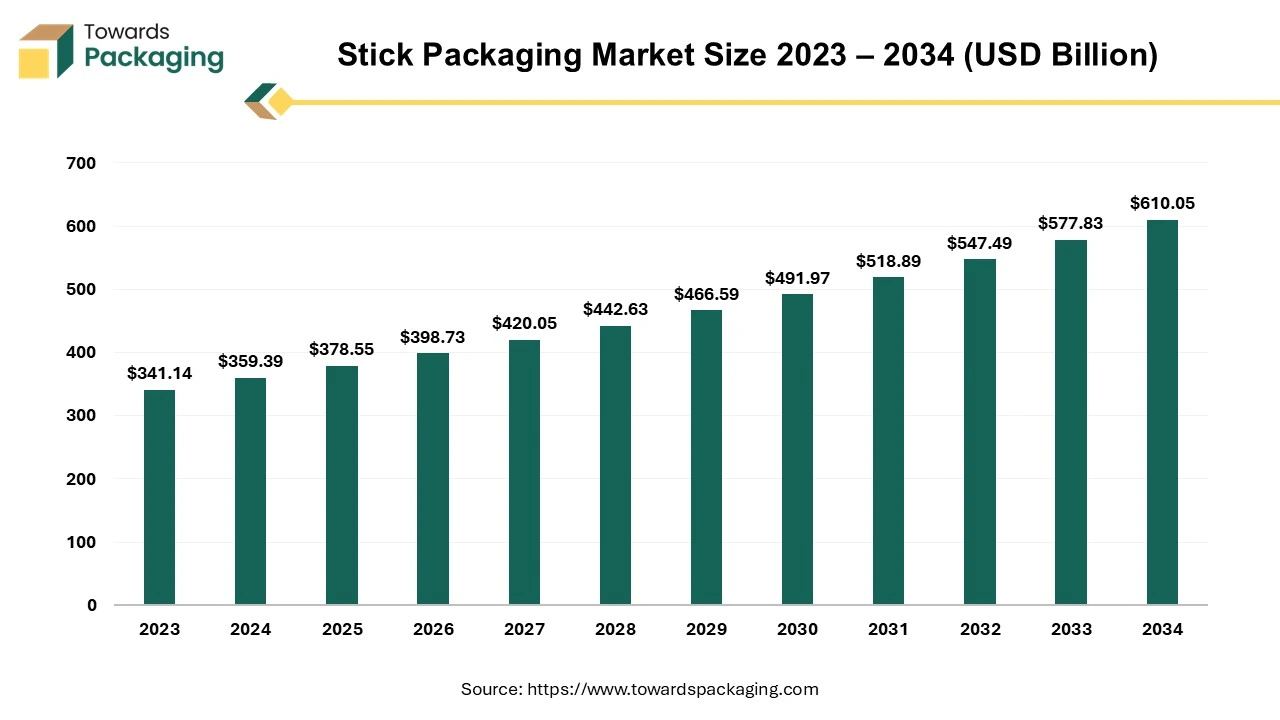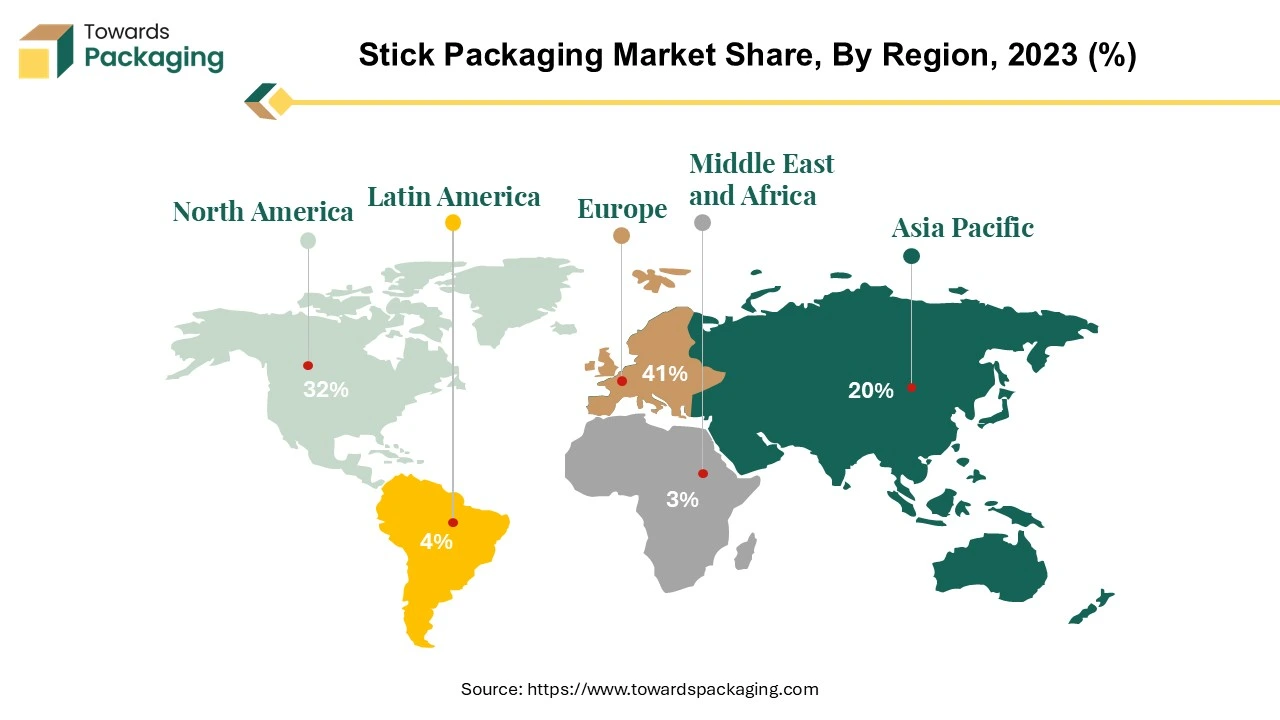April 2025
The stick packaging market size is set to grow from USD 378.55 billion in 2025 to USD 610.05 billion by 2034, with an expected CAGR of 5.4% over the forecast period from 2025 to 2034.

Unlock Infinite Advantages: Subscribe to Annual Membership
Stick pack pouches represent a specialized category of flexible packaging distinguished by their compact dimensions and slender configuration. Specifically designed for the containment of dry powders, though occasionally suitable for powder, gel, solid and liquids, these pouches offer a practical solution for on-the-go consumption. Their narrow and elongated form makes them well-suited for single-serve applications, sample sizes, and products strategically positioned for point-of-purchase display in retail settings.
In 2021, a staggering 16 billion stick packs were procured, underscoring the robust demand for this packaging format. The stick pack packaging market is poised for substantial and profitable expansion. Projections indicate a promising year-over-year growth rate for stick packs, ranging between 5% and 7%. This optimistic forecast suggests a flourishing market with increasing consumer preference for the convenience and versatility of stick packaging solutions. The primary utility of stick pack pouches lies in their convenience and portability. Catering to the modern lifestyle characterized by a demand for quick and hassle-free solutions, these pouches are tailor-made for individuals seeking efficient, single-serving packaging. Stick packs are commonly used for products like instant coffee, sugar, condiments, and pharmaceutical powders, so stick packs ensure easy dispensing and controlled portions, enhancing user experience.
Moreover, stick pack pouches are strategically advantageous for marketing and brand promotion. The elongated surface area provides an opportunity for impactful branding and the inclusion of essential product information. This feature makes stick packs a functional packaging solution and a powerful marketing tool, helping companies establish brand identity and communicate key messages to consumers. The unique attributes of stick pack pouches, including their small size, narrow shape, and suitability for single-serve applications, position them as an optimal choice for businesses aiming to meet consumers evolving preferences who prioritize convenience and on-the-go functionality. These pouches offer a versatile and effective packaging solution, particularly in industries where portability, portion control, and impactful branding are paramount.
The Asia Pacific dominates the stick packaging market, commanding a 41% market share. Following closely, North America holds a 32% market share, while Europe and LAMEA account for 20% and 7%, respectively. The Asia-Pacific region stands out as the leading force, pivotal in shaping the market dynamics. The region's dominance is attributed to a convergence of factors contributing to the robust growth and widespread adoption of stick packaging solutions.
Firstly, the burgeoning population and rapid urbanization in countries like China and India have significantly altered consumer lifestyles, fostering a demand for convenient, on-the-go packaging. Stick packaging, with its compact and single-serve nature, perfectly aligns with consumers preferences in these densely populated regions who seek efficiency and portability in their daily lives. Moreover, the rise of e-commerce and increasing disposable incomes in Asia Pacific further propels the stick packaging market. The adaptability of stick packs to a diverse range of products makes them particularly well suited for the vast array of goods distributed through online retail platforms.
Additionally, the cultural shift towards western-style snacks and beverages, coupled with a growing awareness of sustainable packaging, has fueled the popularity of stick packaging in the region. As consumers become more environmentally conscious, the eco-friendly attributes of paper-based stick packaging resonate well with their preferences. Manufacturers in the Asia-Pacific region actively embrace technological advancements in stick packaging, introducing innovations like notched and easy-open versions. These enhancements enhance user experience, providing consumers with hassle-free and user-friendly packaging solutions.

The Asia-Pacific region emerges as a dynamic hub for stick packaging, driven by demographic trends, economic developments, changing consumer behaviours, and a commitment to sustainability. As the market continues to evolve, the region's influence is expected to persist, making it a focal point for industry players and businesses aiming to capitalize on the growing demand for stick packaging solutions.
As an emerging region in the stick packaging market, North America is increasingly establishing itself as a key player in shaping the trajectory of this dynamic industry. While traditionally recognized for its well established retail infrastructure and consumer driven market, North America is now witnessing a notable surge in the adoption of stick packaging across various sectors. The region's consumers are evolving in preference for on-the-go and single serving packaging solutions, aligning with their fast paced lifestyles.
Additionally, North America's heightened focus on sustainability and eco-conscious practices is propelling the popularity of stick packaging, which offers reduced material usage and enhanced environmental friendliness. The emergence of innovative and diverse applications across industries such as food and beverages, pharmaceuticals, and personal care products further contributes to North America's standing as an influential player in the global stick packaging arena. With a commitment to technological advancements, consumer-centric strategies, and sustainable practices, North America is poised to play a pivotal role in the ongoing evolution and growth of the stick packaging market.
The surge in demand for stick packaging stems from the intersection of on-the-go consumer lifestyles and a preference for eco-friendly solutions. This innovative, flexible packaging, tailored to narrow web formats, aligns seamlessly with modern consumer needs.
The foremost application segment in stick packaging is dedicated to powders, presenting a highly convenient alternative for diverse consumers. They are particularly appealing to individuals with a kettle at home or those who are constantly on the move and still desire their regular beverage; powder stick packaging caters to the evolving lifestyle preferences of modern consumers.
The convenience of powder stick packaging extends beyond its portability, making it an excellent option for customers seeking precise measurements and portion control. This is especially advantageous for those conscious of their intake or requiring accurate quantities for their specific needs. The individual packaging format ensures the preservation of the product's freshness and facilitates an easy way for customers to carry their favourite beverages without taking up excessive space.
While the small, pocket-sized convenience of powder stick packaging is evident, a closer examination reveals many additional benefits. The individualized packaging not only safeguards the integrity of the product but also minimizes the risk of contamination, ensuring that each serving remains pristine. This aspect is particularly crucial for products like pharmaceutical powders or dietary supplements where accuracy and purity are paramount.
The compact and lightweight nature of powder stick packaging aligns seamlessly with the preferences of consumers who prioritize convenience in their daily routines. The easy, tear-open feature enhances accessibility, providing a hassle free experience for users who want a quick and effortless way to enjoy their beverages or supplements. In essence, powder stick packaging addresses the practical aspects of on-the-go consumption and aligns with the broader consumer demand for precision, convenience, and product integrity.
The stick packaging market has emerged as a frontrunner in the food and beverage sector, establishing itself as a leading packaging solution for a myriad of products in this industry. The slender and compact design of stick packs offers unparalleled convenience, making them an ideal choice for single-serve applications, condiments, instant beverages, and a variety of other consumables. In the food and beverage sector, where consumer preferences are continually evolving towards on-the-go convenience and portion control, stick packaging provides a perfect fit.
Production of Cheese around the globe in the year of 2022-2023, Cheese is go-to food product which has the global recognization. Production capacity of cheese varies with the regional and global demand.
The versatility of stick packs extends to various formats, including sachets, tubes, and pouches, accommodating an extensive range of products. Moreover, the appeal of stick packaging lies not only in its practicality but also in its branding potential. The elongated surface area allows for impactful product messaging and branding, enhancing the visual appeal of the packaged goods. As manufacturers and consumers alike recognize the benefits of this packaging format, the stick packaging market continues to lead in the food and beverage sector, setting new standards for convenience, innovation, and brand presentation.
| Most Popular Espresso-Based Drinks in the USA | |
| Type of Drink | Percentage of Coffee Crinkers |
| Cappuccino | 17% |
| Latte | 17% |
| Espresso | 16% |
| Mocha | 13% |
| Americano | 14% |
| Macchiato | 9% |
| Flat White | 6% |
In the USA, the most popular espresso-based drinks are Cappuccino and Latte, each favoured by 17% of coffee drinkers, followed by Espresso (16%), Mocha (13%), Americano (14%), and others.
The global paper-based packaging market, valued at a substantial USD 416.5 billion in 2022, is on the brink of noteworthy expansion, with projections indicating a climb to USD 503.1 billion by 2028. This remarkable surge underscores a vibrant market landscape shaped by evolving consumer preferences and an escalating emphasis on sustainability.
In response to a profound shift in consumer priorities, sustainability has emerged as a pivotal value driver, with a staggering 50% of consumers now ranking it among their 'top 5 value drivers.' 34% of consumers are willing to pay a premium for products and services that prioritize sustainability. This burgeoning inclination towards eco-conscious choices extends beyond the core product and prominently encompasses the realm of packaging. Paper-based packaging stands out as a reasonable alternative, aligning with the growing demand for sustainable practices in the business landscape.
Contrary to the common perception of paper-based packaging being synonymous solely with paper bags, its versatility extends far beyond. This packaging solution manifests in various forms, including corrugated cardboard, folding cardboard boxes, pulp-moulded packaging, cartons, mailers/pouches, and cushioning. Notably, the paper takes the lead as the predominant material segment in stick packaging, where consumers and manufacturers favour its use for its convenience and aesthetic appeal. In essence, the trajectory of the paper-based packaging market encapsulates a narrative of dynamic evolution, with sustainability at its core. As consumers increasingly seek eco-friendly options, businesses are pivoting towards paper-based solutions that meet these demands and offer a versatile array of packaging formats catering to diverse industry needs.
The stick packaging market is currently experiencing a highly competitive landscape characterized by the active participation of key industry players striving for market dominance. Among these players, Amcor plc emerges as a formidable global leader in packaging solutions, encompassing a diverse range of products, with stick packaging being a prominent segment. Amcor's influence extends globally, and the company leverages its extensive technological capabilities to maintain a competitive edge in the market. With a commitment to innovation, Amcor continuously introduces cutting-edge solutions to meet the evolving demands of various industries.
Constantia Flexibles Group GmbH is another significant player in the stick packaging market, focusing on flexible packaging solutions. Recognized for its dedication to sustainability and innovation, Constantia Flexibles has carved a niche in the industry. The company's emphasis on eco-friendly packaging aligns with the growing consumer preference for sustainable practices. Constantia Flexibles strategic approach involves combining quality and innovation, ensuring its solutions meet industry standards and contribute to environmental conservation.
The presence of other key players further enriches the competitive landscape of the stick packaging market, each contributing to the industry's growth and development. These players often differentiate themselves by emphasizing specific aspects such as technological advancements, product diversification, or sustainable practices. As consumer preferences shift towards more convenient and eco-friendly packaging options, critical players in the market continue to adapt and innovate to meet these changing demands.
In this dynamic environment, strategic positioning is essential for sustained success. Companies invest in research and development to stay ahead regarding product offerings and technology. Collaborations and partnerships are becoming increasingly common to pool resources and expertise for mutual benefit. The competitive landscape, therefore, reflects not only individual companies' capabilities but also their ability to navigate and leverage industry trends effectively.
By Material
By Application
By End Use
By Region
April 2025
March 2025
March 2025
March 2025